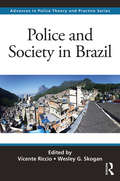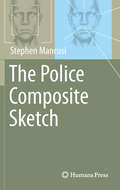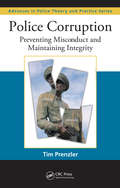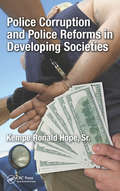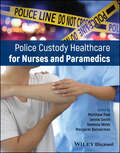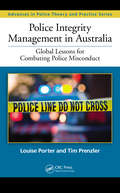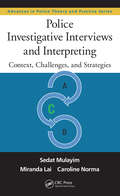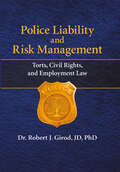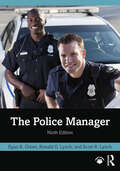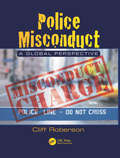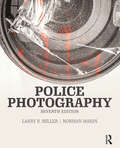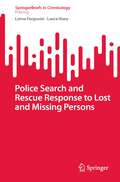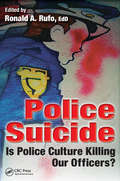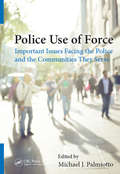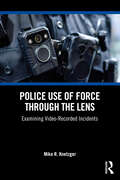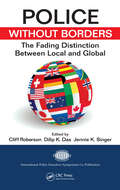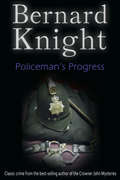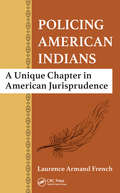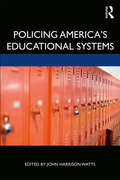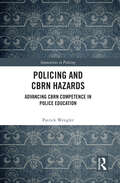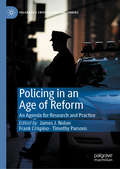- Table View
- List View
Police and Society in Brazil (Advances in Police Theory and Practice)
by Vicente Riccio Wesley G. SkoganIn Brazil, where crime is closely associated with social inequality and failure of the criminal justice system, the police are considered by most to be corrupt, inefficient, and violent, especially when occupying poor areas, and they lack the widespread legitimacy enjoyed by police forces in many nations in the northern hemisphere. This text covers hot-button issues like urban pacification squads, gangs, and drugs, as well as practical topics such as policy, dual civil and military models, and gender relations. The latest volume in the renowned Advances in Police Theory and Practice Series, Police and Society in Brazil fills a gap in English literature about policing in a nation that currently ranks sixth in number of homicides. It is a must-read for criminal justice practitioners, as well as students of international policing.
The Police Composite Sketch
by Stephen MancusiThe police composite sketch, one of the most crucial investigative tools in law enforcement, is developed during a composite session--an intense display of communication and art in which the words of a witness are transformed into the features of a suspect. Despite the incredible technological leaps made in investigative work, the forensic science of composite sketching still relies on the basic elements of drawing skill, interpretive ability and the spoken word. The Police Composite Sketch is a comprehensive manual on how to conduct a complete composite session. Through an array of case studies, it details several disciplines that comprise this specialized forensic art, including composite sketching, image modification, age progression, facial comparison analysis, demonstrative evidence and postmortem/skull reconstruction. It also explores how to intuit insights that are often inadvertently revealed by witnesses, victims and perpetrators during the composite session. In addition, this book discusses other relevant topics, such as the three-stage drawing technique, witness and victim types, descriptive terminologies, managing composite sessions. Complete with numerous illustrations and drawing tips, this seminal work offers a general composite session philosophy and specific session strategies to both experienced and aspiring forensic artists as well as any lay reader intrigued by this fascinating skill.
Police Corruption: Preventing Misconduct and Maintaining Integrity (Advances in Police Theory and Practice)
by Tim PrenzlerWhile many police officers undertake their work conforming to the highest ethical standards, the fact remains that unethical police conduct continues to be a recurring problem around the world. With examples from a range of jurisdictions, Police Corruption: Preventing Misconduct and Maintaining Integrity examines the causes of police misconduct and
Police Corruption and Police Reforms in Developing Societies
by Kempe Ronald Hope Sr.Much of the literature on police corruption and police reforms is dominated by case studies of societies classified as developed. However, under the influence of globalization, developing societies have become a focal point of scholarly interest and examination. Police Corruption and Police Reforms in Developing Societies provides critical analyses
Police Custody Healthcare for Nurses and Paramedics
by Matthew Peel Jennie Smith Vanessa Webb Margaret BannermanAn essential resource for nurses and paramedics navigating the intricate world of police custody, providing a solid guide for both the novices and the veterans in the field Across the UK there are on average over 750,000 episodes of police detentions annually, the equivalent of over 2,000 a day. Each one is entitled to healthcare comparable to the wider community. It is estimated on average 54% of these detained individuals are referred to a healthcare professional because of a complex mix of physical health, mental health, medication, substance misuse or social issues. Healthcare professionals working in custody must navigate this complex mix while working within a short-term detention setting. Police Custody Healthcare for Nurses and Paramedics offers a thorough, accessible introduction to this subject and its key aspects. Nurses and paramedics working in police custody healthcare settings will find a volume that addresses their specific needs, with guidelines for understanding initial patient contact, potential comorbidity, mental illness, forensic sampling, documenting injuries, writing statements, and much more. Aligned to the UK Association of Forensic Nurses and Paramedics’ Advanced Standards in Education and Training (ASET), this is a must-have resource for professionals in this growing area of practice. Readers will also find: The first text written specifically for nurses and paramedics by nurses and paramedics with extensive experience in police custodyDetailed discussion of topics including fitness assessment, medicines management, use of force restraints, and much morePedagogical tools including self-assessment questions, case studies, and learning outcomes Police Custody Healthcare for Nurses and Paramedics is ideal for trainee or registered nurses and paramedics working in police custody healthcare settings or other detention settings.
Police Integrity Management in Australia: Global Lessons for Combating Police Misconduct (Advances In Police Theory And Practice Ser.)
by Louise Porter Tim PrenzlerIn the past two decades, Australia has been the site of major police misconduct scandals and inquiries, leading to reform initiatives at the cutting edge of police integrity management practices. Presenting interviews with key informants and an analysis of key documents, Police Integrity Management in Australia: Global Lessons for Combating Police
Police Investigative Interviews and Interpreting: Context, Challenges, and Strategies (Advances in Police Theory and Practice)
by Sedat Mulayim Miranda Lai Caroline NormaPolice interviews with suspects and witnesses provide some of the most significant evidence in criminal investigations. Frequently challenging, they require special training and skills. This interaction process is further complicated when the suspect or witness does not speak the same language as the interviewer. A professional reference that can b
Police Leadership and Administration: A 21st-Century Strategic Approach
by Gennaro F. Vito William F. Walsh Anthony G. VitoThis innovative text adapts the strategic management process to the police organizational environment, illustrating how to tailor responses to the unique problems and issues that professionals are likely to face in the field of law enforcement. The authors cover pioneering management techniques for leaders facing the challenges of today’s complex environment, offering police executives guidance on planning, setting direction, developing strategy, assessing internal and external environments, creating learning organizations, and managing and evaluating the change process. The book also tackles how to handle the political, economic, social, and technical considerations that differ from one community to the next. Providing a foundation with which to adapt to an ever-changing criminal justice climate, this book trains leaders to search for solutions rather than relying on old formulas and scientific management principles. It is an essential resource for forward-thinking police leadership courses in colleges and professional training programs.
Police Liability and Risk Management: Torts, Civil Rights, and Employment Law
by Robert J GirodLaw enforcement agencies and their employees are continually at risk for potential liability related to torts, civil rights violations, and employment law issues. Litigation may involve suits by the public against officers and the administration, actions by the administration against officers, or actions by officers against the administration or me
The Police Manager
by Egan K. Green Ronald G. Lynch Scott R. LynchThe Police Manager provides a roadmap for the challenges that police administrators face in their day-to-day duties, including considerations for dealing with subordinate officers and for interacting with the public. Covering a wide range of topics, from fiscal management to use-of-force policies, this text prepares readers for the tasks that police managers are confronted with. Readers benefit by gaining a thorough understanding of the complexities involved in an occupation that creates demands from the public, from public officials, and from other police officers. The book delivers information on these issues, with chapters dedicated to leadership styles and planning for leadership loss, as well civil liability considerations. New material in this edition covers specific challenges for small and underexamined police agencies such as university police departments. The Police Manager is an ideal textbook for college students hoping to work in police administration in the future, and is useful for current police managers who know that their jobs require a constant influx of ideas for overcoming new challenges.
Police Misconduct: A Global Perspective
by Cliff RobersonThis book explores the different types of police misconduct including the use of excessive force. It also explores what types of officers become involved in illegal misconduct, steps jurisdictions may take to prevent such problems, and discusses who should police the police. Also included is a historical analysis of police misconduct, discussions on the legal restrictions designed to prevent police misconduct, and steps that the jurisdiction may take to limit their liability. Ancillary material is available with course adoption.
Police Performance Appraisals: A Comparative Perspective (Advances in Police Theory and Practice)
by Serdar Kenan Gul Paul O'ConnellPolice performance appraisal is one of the most important components of law enforcement management affecting the quality of the services a department delivers as well as the satisfaction of its employees. Therefore, it is crucial that the performance appraisal process is conducted in an effective and equitable manner. Police Performance Appraisals:
Police Photography
by Larry S. Miller Norman MarinQuality photographs of evidence can communicate details about crime scenes that otherwise may go unnoticed, making skilled forensic photographers invaluable assets to modern police departments. For those seeking a current and concise guide to the skills necessary in forensic photography, Police Photography , Seventh Edition, provides both introductory and more advanced information about the techniques of police documentation. Completely updated to include information about the latest equipment and techniques recommended for high-quality digital forensic photography, this new edition thoroughly describes the techniques necessary for documenting a range of crime scenes and types of evidence, including homicides, arson, and vehicle incidents. With additional coverage of topics beyond crime scenes, such as surveillance and identification photography, Police Photography , Seventh Edition is an important resource for students and professionals alike.
Police Reserves and Volunteers: Enhancing Organizational Effectiveness and Public Trust
by James F. AlbrechtReductions in police department funding have raised the importance of volunteers in enhancing organizational performance, improving community trust and confidence, and at times accomplishing basic tasks to maintain public safety and security. During a period when police administrators are asked to do more with less, and to engage in smarter, community-oriented policing, citizen volunteers are an invaluable resource. Police Reserves and Volunteers is an invaluable primer for those looking to understand the benefits and challenges involved in the use of the volunteers within global law enforcement agencies. Using cases from a range of specialists and precincts, this edited volume provides a rare window into police administration from the state legislation that regulates police reserves in California to the local models observed in many counties and cities across the United States. Police Reserves and Volunteers offers volunteers, local elected officials, and law enforcement straightforward guidelines to enhance police goals and build public trust in local communities.
Police Search and Rescue Response to Lost and Missing Persons (SpringerBriefs in Criminology)
by Lorna Ferguson Laura HueyThis brief discusses the significant contribution of police search and rescue to the successful location and resolution of missing persons cases. Across seven chapters, this volume offers a detailed examination of the routine practices of police search and rescue personnel. To do so, it draws from a collection of data, including in-depth interviews with police and thousands of different types of missing persons records. Laced with the stories of missing persons, it presents a detailed overview of what these teams do, the processes and procedures employed, and the tools and technologies in police search and rescue. It explores some of the challenges impacting police search and rescue response, emphasizing how to leverage this work in the field. This book also identifies future trends to address the “What may be next” question in the police search and rescue response to missing persons. As the first analysis of the role of police in search and rescue missions, this brief is of interest to law enforcement professionals and researchers of policing, policymakers, and professionals in psychology, criminology, sociology, and beyond
Police Suicide: Is Police Culture Killing Our Officers?
by Ronald A. RufoThere is no question that more police officers die from suicide than those killed in the line of duty. The suicide and attempted suicide of police officers is a mental health concern that has been neglected for far too long.Police Suicide: Is Police Culture Killing Our Officers? provides realistic insight into the life of a police officer through a
Police Use of Force: Important Issues Facing the Police and the Communities They Serve
by Michael J. PalmiottoStarting with a historical introduction, Police Use of Force presents readers with critical and timely issues facing police and the communities they serve when police encounters turn violent. Dr. Palmiotto offers in-depth coverage of the use of force, deadly force, non-lethal weapons, militarization of policing, racism and profiling, legal cases, psychology, perception and training, and violence prevention. Police Use of Force also investigates many case studies, both famous (Rodney King) and contemporary (Ferguson, MO). Essential reading for both criminal justice professionals and academics, this text places police conflict within a complex, modern context, inviting cogent conversation in the classroom and the precinct.
Police Use of Force Through the Lens: Examining Video-Recorded Incidents
by Mike R. KnetzgerPolice Use of Force Through the Lens provides a comprehensive look at video-recorded use-of-force incidents and how video influences perceptions about the appropriateness of the force used. No other book on the market takes a historical, critical, and contemporary look at how video footage from dash cameras, body-worn cameras, surveillance cameras, or handheld cameras influence how people perceive the appropriateness of force used by law enforcement officers, correctional officers, and security officers.Supported with academic sources along with practical examples that connect academics to the real world, the book educates readers about the history of cameras in law enforcement, significant events that influenced the proliferation of cameras in law enforcement, how use-of-force incidents are evaluated, how camera factors influence perceptions, and how human factors can impact how officers perceive and recall what occurred during use-of-force incidents.A thorough discussion of the benefits and disadvantages of cameras—including how camera perspectives can be misleading and incomplete—challenges the presumption of the objectiveness of video and posits a systematic framework to help evaluators or viewers of video-recorded use-of-force incidents arrive at more objective conclusions.
Police Without Borders: The Fading Distinction between Local and Global (International Police Executive Symposium Co-Publications)
by Cliff Roberson Dilip K. Das Jennie K. SingerThe Fifteenth Annual International Police Executive Symposium brought together 65 police executives, government officials, academics, and researchers to discuss issues relating to all aspects of policing in a global community. It focused on policing without borders, the need for national and international cooperation among policing agencies, and th
Policeman's Progress: The Sixties Crime Series (The\sixties Crime Ser. #5)
by Bernard KnightA classic murder mystery by acclaimed crime writer Bernard Knight.Jackie Stott, Tyneside boxer turned nightclub owner – and criminal – seeks to evade the Newcastle police as he stumbles from one dodgy deal to another.When Jackie gets involved in a murder, the police have a reason to try to get him locked up for good – and it’s not just the police who are out to get Jackie, for rival gangland figures are soon gunning for him too!A rip-roaring ride through the nightlife and criminal underworld of a bustling British city during the 1960s.
Policies for Research and Innovation: Proceedings of NERC 2022
by Sukanya Sharma Ramgopal V. S. Uppaluri Vipul Dutta Abhishek KashyapThe book aims to incorporate key findings pertaining to Northeastern India. The papers selected will highlight policies that are critical for fostering research and innovation in critical areas of scientific, social sciences, humanities and associated research paradigms relevant for the North-east.
Policing American Indians: A Unique Chapter in American Jurisprudence
by Laurence Armand FrenchBias, prejudice, and corruption riddle the history of US jurisprudence. Policing American Indians: A Unique Chapter in American Jurisprudence explores these injustices, specifically the treatment of American Indians. A mix of academic research as well as field experience, this book draws on author Laurence French‘s more than 40 years of experience
Policing America's Educational Systems
by John Harrison WattsPolicing America’s Educational Systems, edited by John Harrison Watts, describes methods of policing modern educational settings, covering both K-12 public school and public or private colleges and universities. Using topical examples, subject-matter experts introduce the history of policing in elementary and high schools, the legal context governing educational institutions, and ways to assess risk and prevent or respond to crime, including active-shooter incidents. The opening section covers primary and secondary education, while the second focuses on postsecondary educational settings. A final section offers a theoretical approach to understanding campus crime and discusses the role of counseling and mental health in keeping students safe. A concluding chapter looks at the future of policing in education. Contributors bring both academic and practitioner experience to each topic covered, and useful features include learning objectives, chapter summaries, key terms, and discussion questions that further explore the issues and controversies covered in that section. This textbook is designed for courses in school or campus policing within criminal justice, social work, and sociology programs, and is also appropriate for in-service training for professionals involved in school or campus policing and safety.
Policing and CBRN Hazards: Advancing CBRN Competence in Police Education (Innovations in Policing)
by Patrick WenglerThis book makes an important contribution to police scholarship by focusing on the critical need for law enforcement personnel to receive education on chemical/biological/radiological/nuclear (CBRN) hazards. Under the CBRN umbrella are chemical warfare agents, toxic industrial chemicals, biologically derived toxins, radiological particulate hazards, and other agents, any of which have the potential to inflict bodily harm, incapacitation, or death. Such weapons have been a part of human history for centuries, starting with biological warfare, later shifting over to chemical warfare, and in the last century, radiological and nuclear warfare. The greater availability and accessibility of such materials necessitates that first response and investigation is no longer limited to the military but is required of police forces reacting to incidents in the community, whether acts of terrorism, traffic accidents, or standard industrial incidents. In this book it is argued that basic knowledge of CBRN is essential for police officers at all levels to assess and protect crime scenes, as well as to investigate cases involving CBRN materials. The author uses case studies and technical education to instruct police on how and when CBRN agents can be used maliciously, and the best methods for identifying, analysing, monitoring, and investigating related incidents. The text makes a clear case for integrating CBRN studies into police education so that first responders are enabled to assess incidents and share information with emergency management and other services to determine the most effective equipment and personnel to deploy. This book is essential for police educators and trainers in both universities and police academies, those administering or engaged in in-service police training, and scholars studying policing, criminal justice, and terrorism.
Policing in an Age of Reform: An Agenda for Research and Practice (Palgrave's Critical Policing Studies)
by James J. Nolan Frank Crispino Timothy ParsonsThis book tackles the contentious issue of policing in an age of controversy and uncertainty. It is a timely book written by police scholars — predominantly former practitioners from Europe, Australia and North America — who draw from their own research and operational experiences to illuminate key issues relating to police reform in the present day. While acknowledging some relevance of usual proposed models, such as problem-solving, evidence-based policing and procedural justice, the contributors provide an insider look at a variety of perspectives and approaches to police reform which have emerged in recent decades. It invites university students, criminologists, social scientists, police managers, forensic scientists to question and adapt their perspectives on a broad range of topics such as community policing, hate crime, Islamic radicalisation, neighborhood dynamics, situational policing, antidiscrimination and civil society, police ethics, performance measures, and advances in forensic science, technology, intelligence and more in an accessible and comprehensive manner.
